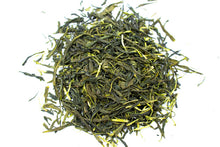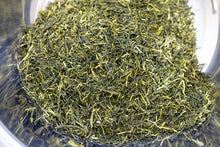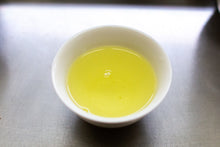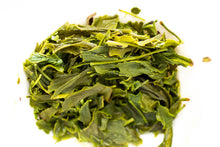
Tsuge Zairai Sencha 都祁在来煎茶 is made from "zairai" tea plucked in spring, from the naturally farmed tea garden located in Tsuge, Nara City, Nara Prefecture.
The tea garden of Tsuge Zairai Sencha is maintained in sustainable manner applying neither pesticide nor fertilizer.
Tsuge Zairai Sencha has a subtle and refreshing floral scent with a hint of sweet nutty note and smooth taste. It has a very long-lasting finishing that lingers down the throat.
In terms of the strength and depth of the finishing/aftertaste, it is the longest among HOJO's Japanese teas.

The tea leaves are slightly rough cut like aracha (crude tea), not those slim-needle-shape. But you may be surprised how delicate and soft the taste of tea is.


Tsuge, which is said to be the center of ancient Japan
Tsuge is located in the Yamato highland in the northeastern part of Nara Prefecture.
Tsuge used to be Tsuge Village, but was merged with Nara City in 2005. Even now, the name Tsuge remains as a place name.
Many myths that seem to be related to the land around Tsugi are described in the Kojiki 古事記(The oldest document of in Japan) . There are a number of heritages in Tsuge.
If you have the greatest interest in the ancient history of Japan, Tsuge is an interesting place to visit.

The soil is rich in minerals
Tsuge Zairai Sencha tea gardens located on the slope of a mountain within walking distance from Kunitsu Shrine and Ogami Shrine. Tsuge, where many ancient historical sites remain, is a land that is not easily eroded by rivers. The area around the tea garden is covered with beige-yellowish clay that has the similar property as Zhuni and is very rich in iron. It is one of the reasons why Tsuge Zairai Sencha has such a long finishing.


For decades, the tea garden was managed with natural farming method. It's pesticide-free and fertilizer-free tea garden.

Tsuge Zairai Sencha Tea Garden and the tea maker
Unlike modern Japanese tea garden with mass production scale, this Tsuge Zairai Sencha tea gardens are in very small scale.
We evaluate the quality of tea from each section of the tea garden owned by the producer, and selected a single tea garden for our lineup.
Quality Tea comes from Healthy Tea
We think that a good example of a healthy plant is a natural plant in the forest or mountain. Plants in nature depend only on the ecosystem for nitrogen intake. As a result, natural plants grow slower and their cells are more compact and dense.
When we search for quality tea, we search for the garden that is maintained in a state similar to the natural plant.
On the contrary, when fertilizers (nitrogen fertilizers, regardless of organic or chemical) are applied, the nitrogen is over saturated in the tea garden. As a result, the tea tree absorbs a lot of nitrogen and it grows fast and vigorously. To support faster growth, tea leaves synthesize a large amount of chlorophyll and actively performs photosynthesis. The cells of the rapidly growing tea leaves are enlarged, leading to low cell density.As a result, although the yield increases, the aftertaste/finishing becomes light and flat.
There are some producers who advertise not using chemical fertilizers, but we believe that both chemical fertilizers and organic fertilizers have the same effect on tea growth as long as they are rich in nitrogen.
Based on our experience, applying the grass and forest's fallen leaves as the fertilizer are not a problem because it is the part of the ecosystem that keeps tea and vegetables in their natural state.
Fertilizer-free cultivation eliminates the need for pesticides
As you can see by observing the plants in nature, they are perfectly sustainable. They have been alive and well for many years even though they have not been given any fertilizer as well as pesticides.
In fact, pests are always looking for the nitrogen through the consumption of leaves. Therefore, tea leaves that contains a higher concentration of nitrogen will eventually attract insects, which is why pesticides are needed.
For example, even if the plants are natural, if they are fertilized, the leaves and their cells will grow larger, the color changes to dark green, and at the same time they will attract insects.
Non-fertilized tea contains a lot of polyphenols and terpenes and low in nitrogen concentration. These physiologically active substances contribute greatly to the taste and aroma of tea; it gives a rich and complex taste, with fruity and floral aroma.
Like natural plants, these tea plants do not require pesticide because insects are not interested in the plant that contains low nitrogen. The producers of Tsuge Zairai Sencha also emphasized the fact that it is almost free of pests.

Fertilizer-free tea grows slowly and does not require vigorous photosynthesis. For this reason, it has less number chlorophyll and generally it is characterized by its yellow-green color.
Seedling tea
Tsuge Zairai Sencha is grown from seedlings.
Seedlings means tea plants are grown from seeds, and are called zairai in Japan.
Originally, Zaire means the name used for the endemic species of Japanese animals and plants such as Japanese serow, or Yamato Iwana. Since tea were originally brought from China, the term "Zairai" is not really appropriate. However, in the Japanese tea industry, Zairai is commonly used for the tea planted by seeding, so HOJO uses the term 'zairai' to make it easier to understand.
The teas of cultivars, such as Yabukita, Okumidori and Benifuki, are planted with cuttings.
When seeds are sown, crossbreeding produces hybrids, so cuttings or grafting are essential to preserve a particular cultivar or variety.
Compared to cuttings, seedling tea has a different root structure.
The photo below shows a clear picture of the different between cuttings and seedling tea.

Cuttings (Cultivated Tea) on the left, seedlings (Grown from Seed) on the right
The tea tree sown from the seed has a long root like a burdock, it's called a taproot. For this reason, it is easy to absorb the minerals in the ground, and the tea has a thicker aftertaste.








